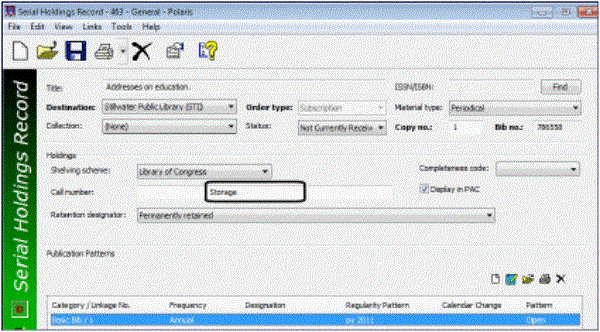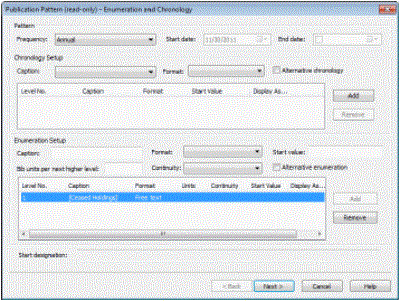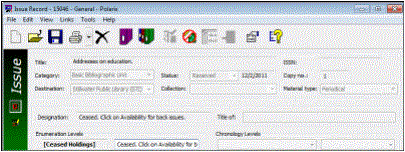Displaying Serial Titles in the PAC
When a patron searches for a serial title in the PAC, the results display according to settings in Polaris Administration and in the Serial Holdings Record. In addition, the compressed holdings statement is generated through the Build up Compressed Holdings statement SQL job. For more information on jobs, see
PAC Profiles Affecting Serials Display
The display of serial titles can be configured at the title level for Polaris PowerPAC and Mobile PAC. However, the item availability display can be configured only for Polaris PowerPAC.
Serial Title Display in PAC
Titles are displayed according to settings in the Title Display: Configure profiles for PowerPAC and Mobile PAC. The profile has selections for configuring the Brief (serial) display, the Full (serial) display, and the Summary (serial) display. If the bibliographic record’s LDR07 has b, i or s, the title displays according to the title configuration settings for serials. If the LDR07 has anything else, the title displays according to the configurations for monographs. For more information on title display options for serials titles,
Tip:
The compressed holdings are built based on the retained issue records using the organization in the linked serial holdings record. If the assigned branch in the linked item record is changed, the item record’s organization can be different from the linked serial issue, making the item’s availability inconsistent with the compressed holdings statement in the PAC display.
Serial Item Availability Display in PowerPAC
Item availability display for serials in Polaris PowerPAC is also affected by the following PowerPAC profiles:
Note:
For more information on availability display options for serials issues, see
- Item Availability: Expand serials titles - If this profile is set to Yes, when you click or tap Availability the location-specific compressed holdings statement and all the issues that are retained will display. If it is set to No, when you click or tap Availability you see only the location-specific holdings information. Click or tap Reference to see individual issues. You can have separate settings for monographic and serials items. The profile Item Availability: Expand non-serials titles can be set to Yes so that patrons do not need to click or tap again to see more information. At the same time, the Item Availability: Expand serials titles can be set to No so that a compressed holdings statement appears for the serials title, and not all the issues.
- Item availability: Display textual holdings notes - The profile can be set to suppress or display textual holdings, display them with a flag icon that the user hovers over or taps to display the textual holdings, or display the textual holdings immediately without the icon.
-
Item availability: Display notes - This profile can be set to display or suppress item or issue public notes, display a flag icon that the user hovers over or taps to see the notes, or display the notes immediately without the icon.
Serial Holdings Record Fields Affecting Serials Display in PAC
The display of serial holdings in PowerPAC and Mobile PAC also depends on the following elements in the Serial Holdings Record:
- Retention designator - Select Retained for a limited period on the General view of the Serial Holdings Record, and specify the range of issues your library retains. The retention information controls the branch-specific compressed holdings statement as well as the number of issues that display under the statement. If you have multiple serial holdings records for the same title and the same branch, but they have different retention periods based on collection, update one of these serial holdings records with the longest retention period. All the serial holding records for the same title and same owning branch share the retention information and the public note. When special or supplemental issues are checked in, the retention information may need to be changed. For example, if the issues are retained for 1 year, and the supplemental issue is checked in a year after the other issues, only the supplemental issue will display in the PAC. See Create a serial holdings record.
- Display in PAC - If this checkbox is unchecked, no issues will display in the PAC (unless there are linked item records that are set to display). If it is checked, the checked in issues display according to the retention information.
- Public Notes - You can enter holdings notes to display at the branch, collection, and/or issue level. The item availability PAC profiles in Polaris Administration control how these notes are displayed in the Polaris PowerPAC. See PAC Profiles Affecting Serials Display.
- Branch level - To display notes at the branch level, enter the notes in the Shared public note box on the Public Notes view of the Serial Holdings Record. The shared public note displays in the PAC even if the prediction pattern is closed and no active issues are linked to the serial holdings record. See Displaying Issues from Ceased Publications in PAC.
- Collection level - To display notes at the collection level, enter them in the Textual holdings and/or Textual holdings public note in the publication pattern for the serial holdings record.
- Issue level - To display notes at the issue or item level, enter them in the Public notes box in the serial issue or item. Notes in the issue record are copied to the item record.
Displaying Issues from Ceased Publications in PAC
When your library no longer receives the publication or the publication has ceased, you can still display the title in the PAC with a note about your library’s holdings. However, to display the public note in the PAC, at least one issue, with or without a linked item, must be generated and checked in.
Follow these general steps to display serial holdings notes for a serial title no longer being received:
- Create a serial holdings record for the title.
Example:
The Call number Storage appears in the PAC, indicating the location of the back issues.

Tip:
The Shared public note appears in the PAC exactly as you type it in the Serial Holdings Record; the lines break in the same place in the PAC.
- On the Public Notes view of the Serial Holdings Record workform, add a public note in the Shared public note box.
Examples:
This periodical ceased publication June 2010.
Library holds the following back issues in storage: v.22, no.1 (Jan. 1997) - v.35, no.6 (Jun 2010)
Some issues missing.
- Create a publication pattern, and generate one issue.
Example:
Enter one level of free text enumeration The designation reflecting the alphabetic or numeric scheme used by the publisher on an item or assigned when the holdings statement is created to identify the individual bibliographic or physical parts and to show the relationship of each unit to the unit as a whole. such as [Ceased Holdings] and no chronology The date(s) used by the publisher on a serially-issued bibliographic unit to help identify or indicate when it was published. The chronology may reflect the dates of coverage, publication, or printing.. The brackets prevent the enumeration from displaying.

- Check in the issue. No linked item is needed.
Example:
In the Issue workform, enter the free text enumeration: Ceased. Click on Availability for back issues.

- Check the PAC display. See Example of PAC Display for a Ceased Serial Publication.
Example of PAC Display for a Ceased Serial Publication
Under the serial title, the following displays:
- Call number: Storage (from the call number in the General view of the Serial Holdings Record workform)
- Holdings: Ceased. Click on Availability for back issues. (from the free-text enumeration in the Issue workform for the single issue)

The user clicks Availability and the note entered in the Shared public note field in the Serial Holding Record workform is displayed. The shared public note lists all holdings, formatted however the library wants to see them displayed.

Related Information
Hold Requests on Serial Items -The Holds options parameter in Polaris Administration can be set to allow only bibliographic-level holds for monographic items, but allow the first copy of a serial issue or volume in a multi-volume set (or both) to be held. For more information, see